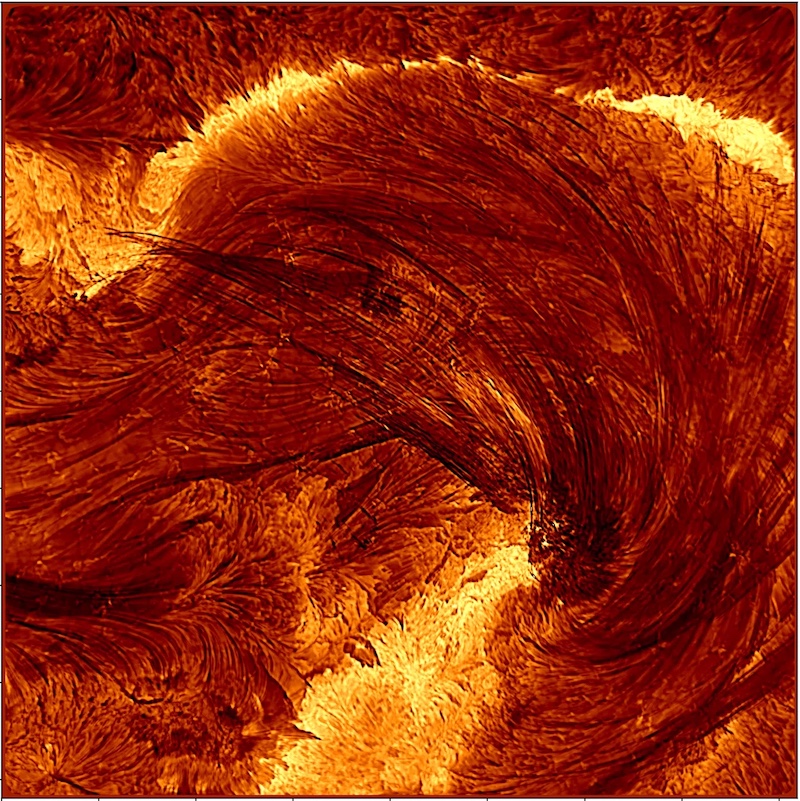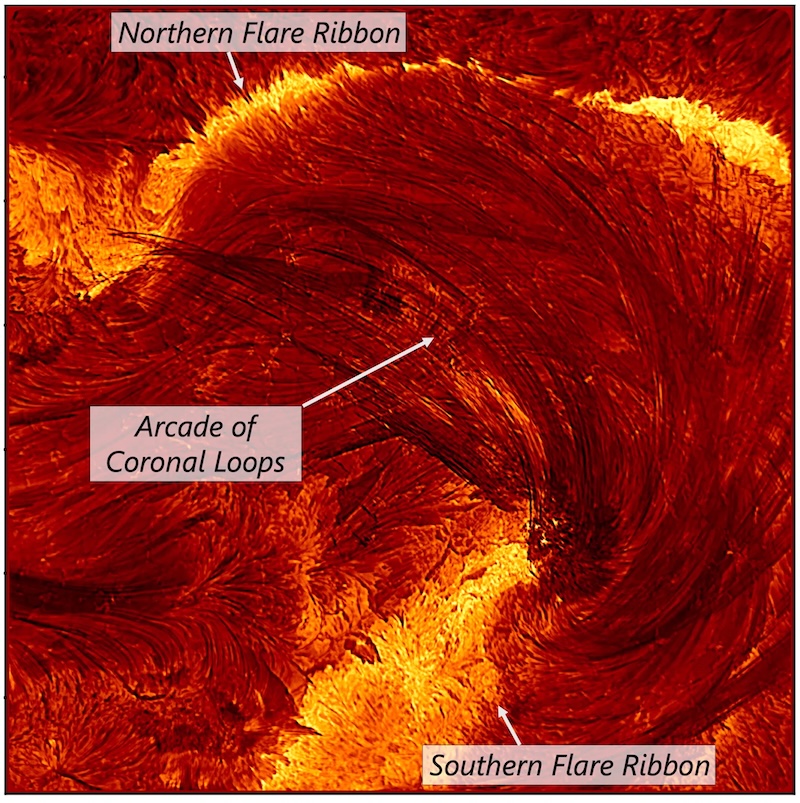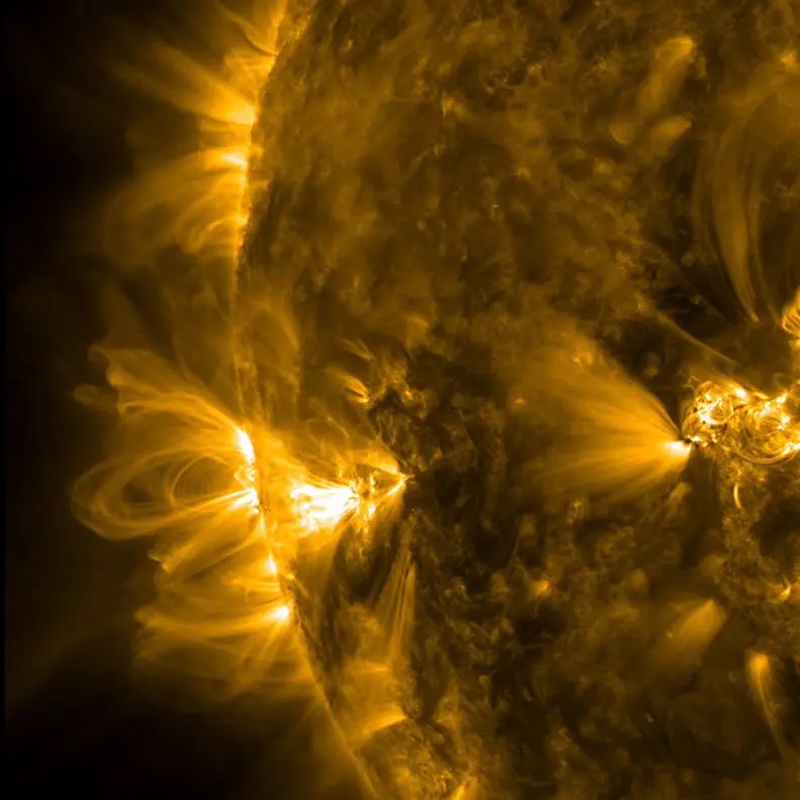
- Solar flares are intense bursts of radiation and light on the sun. Coronal loops, which often precede flares, are huge loops of plasma that arch over the sun’s surface.
- The Daniel K. Inouye Solar Telescope has taken new high-resolution images of a solar flare and coronal loops. They show the smallest loops ever seen, in unprecedented detail.
- The coronal loops look like thin, dark threads and might be the fundamental building blocks of solar flares.
The sun is a highly active place, with huge solar flares and coronal loops of hot plasma erupting from the solar surface. Now, the Daniel K. Inouye Solar Telescope in Hawaii, operated by the National Science Foundation (NSF), has obtained the highest resolution images of a solar flare ever taken. A team of researchers from the National Solar Observatory (NSO) at the University of Colorado Boulder said on August 25, 2025, that the images reveal unprecedented detail in a solar flare and the bright and dark coronal loops within it.
The results will also help scientists to better model solar flares, and improve forecasting of space weather events. Those events, such as intense solar flares, can be dangerous for satellites, power grids and communications.
The researchers published the new solar flare images and data in a peer-reviewed paper in The Astrophysical Journal Letters on August 25, 2025.
New solar flare images
The Daniel K. Inouye Solar Telescope took the images at the Hydrogen Alpha (H-alpha) wavelength (656.28 nm), on August 8, 2024. The X1.3-class (strong) flare was in its decay phase at the time. The telescope saw the smallest coronal loops ever, only 30 miles (48 km) wide on average. Some were as thin as 13 miles (21 km). In fact, these are the highest-resolution images ever obtained of a solar flare and its coronal loops.
Cole Tamburri is the lead author of the new study. He said:
This is the first time the Inouye Solar Telescope has ever observed an X-class flare. These flares are among the most energetic events our star produces, and we were fortunate to catch this one under perfect observing conditions.
This is a high-cadence, high-resolution movie of the flare captured by the Daniel K. Inouye Solar Telescope. It is sped up by 100 times, and both bright ribbons and dark overlying coronal loops are visible. The image is about 4 Earth-diameters on each side. Video via NSF/ NSO/ AURA.


Check out our sun news, updated daily!
Coronal loops in unprecedented detail
The study focused primarily on coronal loops in the solar flare. Basically, those are giant loops of hot plasma arching over the sun’s surface. They tend to follow the magnetic field lines of the sun. They also often precede solar flares.
The telescope observed hundreds of coronal loops at a level of detail never achieved before. They measured about 30 miles (48 km) across on average. Some of the loops, however, were even thinner, only about 13 miles (21 km) across. This is right at the limits of the telescope’s resolution capabilities. Tamburri said:
Before Inouye, we could only imagine what this scale looked like. Now we can see it directly. These are the smallest coronal loops ever imaged on the sun.
The coronal loops look like dark threads against the bright ribbons of the solar flare.
The observations help confirm what scientists had suspected previously. That coronal loops could be as narrow as 6 miles (10 km) and as wide as 62 miles (100km). As Tamburri noted:
We’re finally peering into the spatial scales we’ve been speculating about for years. This opens the door to studying not just their size, but their shapes, their evolution and even the scales where magnetic reconnection – the engine behind flares – occurs.
It’s a landmark moment in solar science. We’re finally seeing the sun at the scales it works on.
The NSF Inouye Solar Telescope just captured this extreme-resolution video of an X-Class flare (the nastiest kind) on the Sun. It's sped up by a factor of 100 so you can see the seething streamers of plasma.This scene is 4x as wide as the entire Earth. ??nso.edu/press-releas…
— Corey S. Powell (@coreyspowell.bsky.social) 2025-08-27T22:03:56.973Z

Are coronal loops the building blocks of flares?
The new solar flare images also suggest another intriguing possibility: that the loops are essentially the building block of the larger solar flares. Tamburri said:
If that’s the case, we’re not just resolving bundles of loops; we’re resolving individual loops for the first time. It’s like going from seeing a forest to suddenly seeing every single tree.
Overall, the images are providing a glimpse of our sun – the closest star – in ways not possible before. As co-author Maria Kazachenko at the National Solar Laboratory noted:
Knowing a telescope can theoretically do something is one thing. Actually watching it perform at that limit is exhilarating.
Bottom line: New solar flare images from the Daniel K. Inouye Solar Telescope reveal a solar flare and coronal loops in unprecedented high-resolution detail.
Source: Unveiling Unprecedented Fine Structure in Coronal Flare Loops with the DKIST
Via National Solar Observatory
Read more: A solar flare 10 billion times more powerful than sun’s
Read more: Will solar flares destroy modern civilization? Nah











